
Contents
Overview
Operating Systems
TRSDOS
NEWDOS
NEWDOS Commands
MULTIDOS
DOSPLUS
VTOS
LDOS
LDOS Internals
Other Hardware
M1 Internals
ROM Addresses
RAM Addresses
Model 1
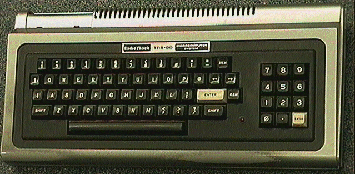
Model 1 OverviewThe TRS-80 Model 1 was Radio Shack's first personal computer. It was developed back in the late 1970's when the only home computers available to the general public were things like the Altair kits, and (if I remember correctly) the first Apple machine. The Model 1 was first made available with a 4 kilobyte tiny BASIC in ROM, and either 4 or 16 kilobytes of RAM. The CPU board of the computer was contained in the keyboard unit, and it used a separate black and white monitor. The monitor was really a RCA black and white TV without the TV guts in it. A friend of mine had one, and I was almost able to talk her out of it. (Thanks to Robert Bottomley who corrected me when I remembered it as a Sony!) The Level 1 BASIC was very limited. There were 26 number variables available, A through Z, two string variables (A$ and B$) of up to sixteen(!) whole characters each, and one array, A(x) that allowed as many elements as you had RAM for. With a 4K machine, that was right around 875. I managed to find the box that my Level I BASIC manual was in, and finally looked it up. Here's something I got in an email from Rob Ricci < robricci@nanospace.com>
Later, the ROM was upgraded to a 12K "Level 2" BASIC, which was much more advanced. Level 2 BASIC was actually useful to write real programs in, though all it supported for storage of programs and data was cassette tape. Level 2 BASIC and 16K of RAM became the "standard" configuration. If you're interested, there's a Level II BASIC reference on the web. You can find it at http://keaggy.intmed.mcw.edu/trs80.html. To get real use out of the Model 1, you needed the Expansion Interface which would let you go above 16K of RAM to 32K or even 48K. It also had a provision for using two cassette tape units, a printer port, the floppy disk controller (which controlled up to four floppy disk drives) , and a serial port. Finally, it supplied the processor with a real-time clock interrupt that was used by the various DOS systems (and a couple of cassette based ROM enhancements) for time keeping functions. Microsoft had a Level III BASIC that loaded from cassette and made several useful additions to the standard BASIC. The main problem with the machine was the interconnection between the keyboard and the expansion interface. It used a 40 conductor ribbon cable, and the connectors would get dirty quickly. There was nothing more frustrating than to have a large program typed in only to have the machine decide it wanted to reset itself. The other problem was flakey connections at the serial port board. All these contributed to the name "Trash-80". The interconnect problem was bad enough to give rise to several companies that sold gold-plated connectors that could be soldered to the machine. Another problem that occurred with the expansion interface had to do with timing and buffering. Some revisions of the CPU unit and some of the expansion interface required a special cable between the two of them. I've been lucky so far, in that all my CPUs and EIs have worked together with just a plain old ribbon cable. |
Model 1 Disk Operating SystemsThere were quite a few disk operating systems available for the TRS-80 Model 1. It all stemmed from the fact that the original TRSDOS from Radio Shack was utter garbage. Several other companies developed their own (surprisingly compatible) operating systems for the machine, and in no time at all, the Model 1 was a useful machine. <grin> There was even a version of CP/M 1.4 available for the Model 1, but since the ROM, keyboard and video were unable to be remapped out of the low memory area, special CP/M programs had to be used with it. That sort of defeated the whole purpose of running CP/M, however. I've still got some old CP/M 1.4 disks around here somewhere. If I can find them, I'll boot them up and try to find out who they're from. In all the different TRSDOS type operating systems, there were several common features they all shared. Among these were: Disk drives were refered to as :0 to :3, file names were eight characters with an optional three character extension, the separator for the extension was a slash (/), and if a file was protected with a password, it consisted of up to eight characters separated from the filename by the period character. There are many other common features, but they will not be discussed here. Below, the major operating systems for the TRS-80 Model 1 are listed, along with some comments from myself and others. |
TRSDOS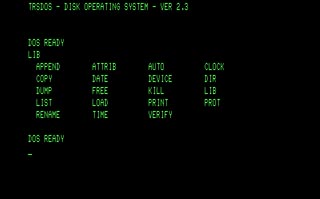
TRSDOS was the standard disk operating system for the Model 1. When you bought a disk based machine, that's what you got. Version 2.1 was the first widely distributed version, and it was seriously buggy. The main problem it had was it would "lose" files for you. Version 2.2 fixed most of the problems (but not all), and was released a little bit after two guys in Denver released their own fixes, called NEWDOS. The final version, 2.3, is not too bad, but it still had a few bugs. |
NEWDOS and NEWDOS/80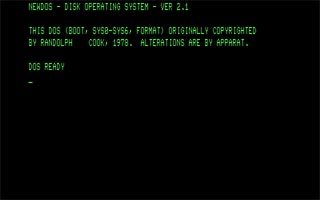
TRSDOS (before version 2.3) was, to be blunt, horrible. Two fellows out in Colorado started a company called Apparat, and they fixed almost all the problems with TRSDOS 2.1 and released NEWDOS. Not only did they get it out the door with very few bugs, they admitted them when they were found, and sent out fixes right away. That's quite a contrast from the attitude Tandy had... It seemed like Tandy's favorite saying at the time was "not fully implemented". NEWDOS included a disk editor, a program relocator, and extensions to the Radio Shack editor/assembler package, making it a very good choice for programmers. The picture above is of a NEWDOS 2.1 system after displaying the list of library commands. 
NEWDOS/80 was their later release. It was another extremely powerful operating system, which allowed the user to specify just about anything they wanted to about their disks. It was so powerful, it was more of a "programmer's only" operating system than one for users. This is a picture of NEWDOS/80 version 1.0. On the Model III page, there is a picture of version 2.0 NewDos/80 was probably the most configurable operating system ever devised by man. You want a custom disk format? No problem... just learn how to use the PDRIVE utility and you can set up just about anything you want. The only problem I had with NewDos/80 was remembering what all the switches did. There were TONS of them. Everywhere. On every command. Agghhhh! Lots of people swear by it, and it's a good system. I mostly swore *at* it. From Shawn Sijnstra (shawn@maths.unsw.edu.au), slightly edited:
You just did mention them. (grin) Thanks Shawn - That helps fill this section out a bit. There's a TRS-80 Clone info page, too, which gives a little more information about the Model I clones. If you would like to see it, there is a page of NewDos/80 Commands that gives a rundown of the commands available on both the Model 1 and Model 3 versions of NewDos/80. |
MULTIDOS
Multidos was written by Vernon Hestor, and sold through Cosmopolitan Electronics. Somewhere around here I've got about half of an older (relatively older, that is) revision of the manual. If I can ever find the silly thing, I'll see what I can add. Vernon recently emailed me, asking what I would like to know about Multidos, so I should be able to add a bunch of stuff to this part of the page. I am not sure where to start asking questions, though, since I don't know much about it. I just told him that whatever he wanted to share about it would be nice. Hopefully I'll be getting something soon. From: Shawn Sijnstra < shawn@solution.maths.unsw.edu.au>
From: Albert Hartman < compexpr@tribeca.ios.com>
Finally, I have this bit of info about Vernon and MultiDOS from Johnn Audritsch <jaudrits@ix.netcom.com>
|
DOSPLUS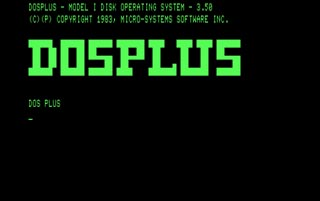
A company down in Florida, Micro-Systems Software, was responsible for DOSPLUS. This was another good Model 1 operating system, with quite a few bells and whistles. The first version I ever used was DOSPLUS 3.5, and I was immediately impressed. Like NEWDOS, there were quite a few embellishments for programmer types, but there were also a lot of things that made it easier for the user, too. A program called MEDIC (or was it CODIR?) was available to give a nice menu of all the programs on a disk, and let the user pick what to run with the arrow keys. Enhancements to the Disk BASIC included an INPUT@ function, an array sorting utility, and several others. Much like LDOS (discussed later), DOSPLUS supported the idea of device independence. The screen, keyboard and printer devices could all be redirected to each other, or to a file. This was generally a "Good Thing". DOSPLUS supported hard disks, though I never used one with it. |
VTOSSorry, but there's no picture of this one. Randy Cook, the author of TRSDOS 2.1, released his own TRS-80 operating system, called VTOS 3.0. It fixed a lot of bugs in TRSDOS 2.1, but it also had its own share of them. Not many people took a liking to it, even though it had a ton of bells and whistles, mainly because it was "copy protected". Sector 4 of track 0 was unformatted on system disks, and it wouldn't run otherwise. Tim Mann sent me some amazing email not too long ago. He got into the TRS-80 operating system business (he worked for Logical Systems) by buying a copy of VTOS 3.0, disassembling it, and fixing some bugs. While he was at it, he learned (just for fun) how to disable the copy protection. In addition to that, he found that there was code on the disk that you could activate to turn the disk into a reproduction master! Once you booted the modified disk, all attached floppy drives would start scanning for new blank floppies. Whenever you inserted one, it would be formatted and made into a copy-protected master disk that could in turn make non-copyable system disks! Talk about defeating copy protection! At the time, Randy was distributing VTOS 4.0 through PowerSoft. He was later contacted by Lobo Drives (makers of the LX-80 Expansion Interface clone and later the MX-80 computer) to get an operating system for the LX-80, which wasn't fully compatible with Radio Shack hardware. Unfortunately for Powersoft, he sold VTOS 4.0 to Lobo. Apparently, from what I've heard, he was a little slow getting bug fixes to them, though, and refused to deliver any of the source code to the operating system, so they brought in some other people (including Bill Schroeder of Galactic Software and Roy Soltoff of Misosys) and started working on it themselves. Eventually, they turned VTOS into LDOS, or "Lobo Disk Operating System". |
LDOS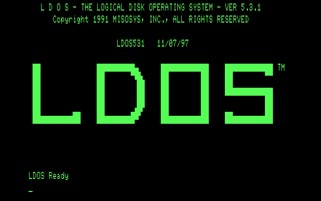
LDOS, from Logical Systems, Inc., was the result of Bill and Roy realizing that they had a good operating system for non-Lobo systems. They formed Logical Systems (named partly because they needed something that started with the letter L) after Lobo became less involved. LDOS was was another of the extremely powerful TRS-80 operating systems (it seems like they *all* were, other than TRSDOS), which used the concept of device independence in almost everything it did. The printer could be routed to a disk file, the keyboard and display could be linked to the comm port, and filters could be applied to the keyboard to allow one key to generate dozens of keystrokes. LDOS was probably the best all-around operating system available for the TRS-80 line. In fact, it was chosen by Tandy to be the operating system for Model 1 and Model III hard disk systems. This led to LSI's eventual development of TRSDOS 6 for the Model 4. Logical Systems tried (and succeeded) in making all their operating systems compatible with each other as far as disk formats go. A Model 1 LDOS disk can be read in Model 3 LDOS or TRSDOS 6 with no problems. This made it my favorite operating system, though the others have their strong points, too. LDOS was the last operating system still supported for the Model 1. The final version of it, 5.3.1, added support for dates past the year 2000. If you're interested, here is a page full of LDOS Internals. This has lots of good programming information for both the Model 1 and Model 3 versions of LDOS. If you'd rather have the full LDOS 5.x manual in Microsoft(TM) Word (probably another (TM) goes here) or ASCII format, you should head over to Tim Mann's TRS-80 page. He also has disk images of LDOS 5.3.1 that can be used with the various Model 1 and III emulators that are available. |
Other hardware and stuffDouble Density Floppies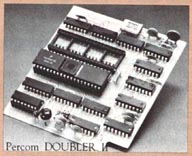
In addition to the standard Western Digital FD1771 based disk controller, which only supported single-density, there were a number of different double-density kits made available. The third-party ones worked rather well. The Radio Shack one also worked, but was incompatible with most of the others. (What else would you expect!) I never had the "pleasure" of running the double-density TRSDOS that Radio Shack came out with, mainly because I used the wrong Double Density controller, but from what I hear, the other operating systems were better, anyway. Pictured above is one of the double density adapters available, the Percom Doubler II. I used the one from Aerocomp, but don't have a picture of it scanned in yet. Exatron Stringy FloppyAnother nice addition was the Exatron Stringy Floppy. These were small tapes that recorded at high speed, making a non-disk TRS-80 into a much easier to use system. I really need more information about the ESF, though, because I've never actually seen one "live" as it were. Omikron MapperThe Omikron Mapper, delivered starting 1979, is a circuit board with some components and a bootrom which is plugged into the Z80 socket. The Mapper displays a boot menu. When the option "CP/M" is chosen, the TRS-80 memory is remapped so that RAM starts at address 0000 and keyboard/video memory is in upper memory. This enables the TRS-80 to run standard CP/M 2.2, which was supplied with the Mapper. Micro MerlinThe Micro Merlin (by Micro Projects Engineering 1983-1984) add-on enabled the TRS-80 Model I to run MS-DOS. The Micro Merlin consisted of a metal box containing a board with 8088 processor, 256 kB memory, printer port and serial port. The board of the Micro Merlin was connected to the TRS-80 40-pin expension connector or to the TRS-80 standard expansion interface. The TRS-80 is booted with a TRS-80 compatible Dos (e.g. TRSDOS). A TRSDOS program is then started, which makes the TRS-80 a slave to the Micro Merlin. The TRS-80 does all keyboard, screen and disk I/O for the Micro Merlin board. Now MS-Dos can be booted. The Micro Merlin was supplied with MS-DOS 2.0. Etc.Speaking of hardware... One of the best books I ever read for the Model 1 was called The Custom TRS-80 and Other Mysteries, written by Dennis Bathory-Kitsz, and published by IJG, Inc. There were plans for a music synthesizer, a flashing-light front panel, and all sorts of modifications that could be made to the machine to make it run faster and better. There were also a number of other books in the "..and Other Mysteries" series, and they were all good. If you're interested, Dennis is on the World Wide Web, himself. Check out his home page at http://www.maltedmedia.com/. (Special COCO lovers note: He apparently still has some copies of "Learning the 6809" that he'll let go for ten bucks apiece. Email him for more info.) Back to the Model 1, more hardware information, such as important memory and port addresses, can be found on the Model 1 Internals Page, which might still be under construction. |
The TRS-80 Home Page created and maintained by Pete Cervasio
cervasio@airmail.net
Copyright © 1998 Pete Cervasio